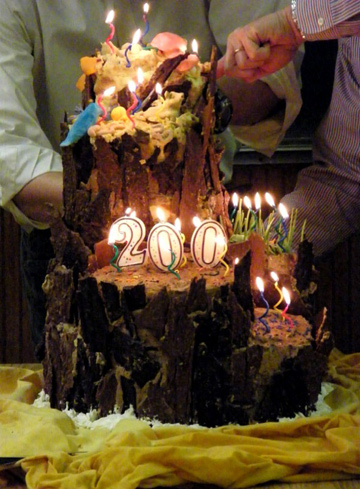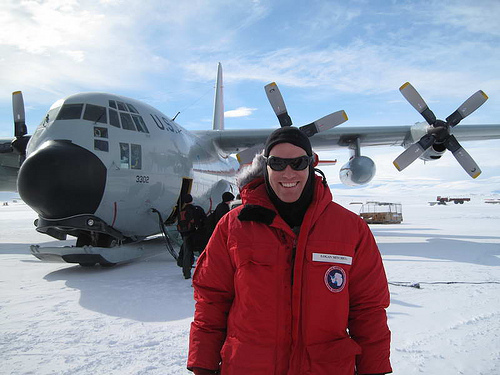The Zoology Department had a little celebration today in honor of Charles Darwin, complete with a cake worthy of a 200th birthday:

The Zoology Department had a little celebration today in honor of Charles Darwin, complete with a cake worthy of a 200th birthday:

Three words we hear a lot of these days, and with good reason.
• We need to build a pipeline of future scientists.
• We know lectures don’t inspire students.
• Mentoring is essential for a young investigator.
• Work readiness is an expectation of potential employers.
• College of Science undergraduate students are really really smart and help advance their faculty mentors’ science.
And thus, we have the OSU Summer Undergraduate Research Program, which is funded by the Howard Hughes Medical Institute. Here you can find streaming videos of student presentations about their work, downloadable journal articles on their research, and — coming in late January — an application for the 2009 program.
OSU Geologists contributed to a new exhibit at the capitol building in Salem.
With help from geologists at OSU, the Oregon Historical Society unveiled a new exhibit – called “150 Years of Statehood; 150 Million Years in the Making’ – in the capitol building in Salem.
The displays, which are spread along four banks of windows near the information desk at the capitol, took more than two years to organize.
The Capitol building is located at 900 Court Street NE in Salem and is open from 8am-5pm, Monday-Friday. To celebrate Oregon’s 150th birthday, there will be a family day at the Capitol on Saturday, February 14th — a perfect opportunity to check out the display! Watch their website for more information.
While concluding that some projections of the impact of climate change have actually been too conservative – as in the case of glacier and ice sheets that are moving and decaying faster than predicted – others may not pose as immediate a threat as some scenarios had projected, such as the rapid releases of methane or dramatic shifts in the ocean current patterns that help keep Europe warm.
Researchers have discovered that grazing animals including deer and rabbits are actually helping to spread plant disease – quadrupling its prevalence in some cases – and encouraging an invasion of annual grasses that threatens more than 20 million acres of native grasslands in California.
President Ray’s quarterly report brings us news of the EarthScope Program:
A first-of-its-kind transcontinental project called EarthScope, whose national office is located at OSU, is giving geologists an unprecedented look into the depths of North America. Their work is already turning up clues about silent quakes, creaking fault lines and the potential for a tremor to become a convulsion that topples buildings and sends tsunamis racing toward shore.
 This news is spreading like wildfire today: OSU’s Dr. Jane Lubchenco has been chosen by President-elect Obama to lead the National Oceanic and Atmospheric Administration.
This news is spreading like wildfire today: OSU’s Dr. Jane Lubchenco has been chosen by President-elect Obama to lead the National Oceanic and Atmospheric Administration.
We are very proud and excited to see Jane take on this role.
Here are some news links!
Obama’s new hotshot at NOAA – Los Angeles Times
Lubchenco Brings Northwest Experience to NOAA – OPB News
Lubchenco faces toughest test at NOAA – The Oregonian
Advocates for Action on Global Warming Chosen as Obama’s Top Science Advisers – The Washington Post
The Oregon Mathematics Leadership Institute is a partnership between Oregon State University, Portland State University, Teachers Development Group, and 10 Oregon school districts, with approximately 180 teachers and 100 administrators participating across the 10 partner districts. OMLI works to build collaborative professional learning communities within the participating schools through a series of intensive summer institutes and follow-up academic year professional development activities for teams of teachers and administrators.
The primary activity of the OMLI project is the development of a cadre of mathematics teachers as school -and district-based intellectual leaders and master teachers through a series of intensive summer institutes and follow-up academic year activities. Three consecutive summer institutes (2005, 2006, 2007) combined rigorous and relevant mathematics content coursework with leadership development workshops and seminars. Academic year activities facilitate the ongoing development of collaborative professional learning communities of K-12 teachers, school administrators, and higher education faculty. The central research theme for the project’s evaluation plan is on improving mathematical discourse in the classroom.
The summer institutes included mathematics content coursework across six strands: numbers and operations, algebraic structures, measure and change, geometry, data analysis and probability, and discrete mathematics. The mathematics content coursework was complemented by leadership development coursework. Academic year activities facilitate the ongoing development of collaborative professional learning communities within each participating school. These activities promote student discourse in mathematics and to increase student achievement in mathematics.
The OMLI Partnership received major funding from the National Science Foundation and additional funding through the Oregon Department of Education in support of its activities. Oregon State University serves as the lead institution in the partnership.
OMLI Project Leaders
Principal Investigator: Thomas Dick, Oregon State University, Mathematics Department
Co-PI: Karen Higgins, Oregon State University, School of Education
Co-PI and Project Director: Linda Foreman, Teachers Development Group
Project Evaluator: David Weaver, Senior Research Associate, RMC Research Corporation
OMLI Partner Institutions
Oregon K-12 School District Partners: Beaverton, Bend-LaPine, Crook County, Molalla River, North Clackamas, Redmond, Reynolds, Roseburg, South Lane, and Woodburn
University Partners: Oregon State University (OSU) and Portland State University (PSU)
Non-Profit Partner: Teachers Development Group (TDG), a 501(c)(3) nonprofit mathematics professional development organization and affiliate of Portland State University’s Department of Mathematics and Statistics
Additional interesting reading: Most Likely to Succeed by Malcolm Gladwell in The New Yorker

Logan Mitchell arrives in Antarctica
We have an exciting blog to share today. Ph.D. student Logan Mitchell is spending two months working at the Western Antarctic Ice Sheet (WAIS) Divide research station in Antarctica, as a member of a National Science Foundation-funded project that aims to collect a 3.5 kilometer-long ice core over three summer seasons. The intention is to provide Antarctic records of environmental change for the last 100,000 years.
The blog and the accompanying photos on Flickr will give us a glimpse of what it means to be a scientist working in such an extreme location.

“It’s very difficult to have one model that you follow with all students,” says Bottomley. “You have to see students individually, giving them opportunities to recognize their own strengths.”
Mentorship is not a new thing for Peter Bottomley, professor of microbiology in the College of Science. Back in 2006, Peter became the very first recipient of the Excellence in Graduate Mentoring Award, given by the OSU Graduate School.
These days, Peter is part of the Mentor Program at OSU. He and former student Shawn Starkenburg (’08) are featured on banners around campus, and here on the Mentor website. They also appeared in the Summer 2008 edition of Terra Magazine.
| M | T | W | T | F | S | S |
|---|---|---|---|---|---|---|
| 1 | 2 | 3 | 4 | 5 | 6 | 7 |
| 8 | 9 | 10 | 11 | 12 | 13 | 14 |
| 15 | 16 | 17 | 18 | 19 | 20 | 21 |
| 22 | 23 | 24 | 25 | 26 | 27 | 28 |
| 29 | 30 | 31 | ||||